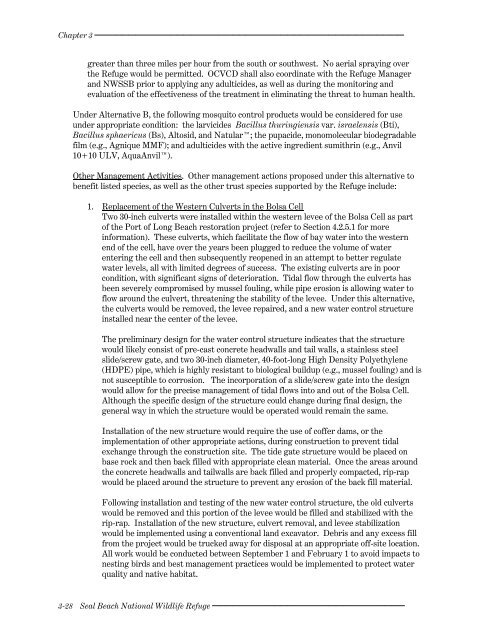Chapters 1 - U.S. Fish and Wildlife Service
Chapters 1 - U.S. Fish and Wildlife Service
Chapters 1 - U.S. Fish and Wildlife Service
You also want an ePaper? Increase the reach of your titles
YUMPU automatically turns print PDFs into web optimized ePapers that Google loves.
Chapter 3 <br />
greater than three miles per hour from the south or southwest. No aerial spraying over<br />
the Refuge would be permitted. OCVCD shall also coordinate with the Refuge Manager<br />
<strong>and</strong> NWSSB prior to applying any adulticides, as well as during the monitoring <strong>and</strong><br />
evaluation of the effectiveness of the treatment in eliminating the threat to human health.<br />
Under Alternative B, the following mosquito control products would be considered for use<br />
under appropriate condition: the larvicides Bacillus thuringiensis var. israelensis (Bti),<br />
Bacillus sphaericus (Bs), Altosid, <strong>and</strong> Natular; the pupacide, monomolecular biodegradable<br />
film (e.g., Agnique MMF); <strong>and</strong> adulticides with the active ingredient sumithrin (e.g., Anvil<br />
10+10 ULV, AquaAnvil).<br />
Other Management Activities. Other management actions proposed under this alternative to<br />
benefit listed species, as well as the other trust species supported by the Refuge include:<br />
1. Replacement of the Western Culverts in the Bolsa Cell<br />
Two 30-inch culverts were installed within the western levee of the Bolsa Cell as part<br />
of the Port of Long Beach restoration project (refer to Section 4.2.5.1 for more<br />
information). These culverts, which facilitate the flow of bay water into the western<br />
end of the cell, have over the years been plugged to reduce the volume of water<br />
entering the cell <strong>and</strong> then subsequently reopened in an attempt to better regulate<br />
water levels, all with limited degrees of success. The existing culverts are in poor<br />
condition, with significant signs of deterioration. Tidal flow through the culverts has<br />
been severely compromised by mussel fouling, while pipe erosion is allowing water to<br />
flow around the culvert, threatening the stability of the levee. Under this alternative,<br />
the culverts would be removed, the levee repaired, <strong>and</strong> a new water control structure<br />
installed near the center of the levee.<br />
The preliminary design for the water control structure indicates that the structure<br />
would likely consist of pre-cast concrete headwalls <strong>and</strong> tail walls, a stainless steel<br />
slide/screw gate, <strong>and</strong> two 30-inch diameter, 40-foot-long High Density Polyethylene<br />
(HDPE) pipe, which is highly resistant to biological buildup (e.g., mussel fouling) <strong>and</strong> is<br />
not susceptible to corrosion. The incorporation of a slide/screw gate into the design<br />
would allow for the precise management of tidal flows into <strong>and</strong> out of the Bolsa Cell.<br />
Although the specific design of the structure could change during final design, the<br />
general way in which the structure would be operated would remain the same.<br />
Installation of the new structure would require the use of coffer dams, or the<br />
implementation of other appropriate actions, during construction to prevent tidal<br />
exchange through the construction site. The tide gate structure would be placed on<br />
base rock <strong>and</strong> then back filled with appropriate clean material. Once the areas around<br />
the concrete headwalls <strong>and</strong> tailwalls are back filled <strong>and</strong> properly compacted, rip-rap<br />
would be placed around the structure to prevent any erosion of the back fill material.<br />
Following installation <strong>and</strong> testing of the new water control structure, the old culverts<br />
would be removed <strong>and</strong> this portion of the levee would be filled <strong>and</strong> stabilized with the<br />
rip-rap. Installation of the new structure, culvert removal, <strong>and</strong> levee stabilization<br />
would be implemented using a conventional l<strong>and</strong> excavator. Debris <strong>and</strong> any excess fill<br />
from the project would be trucked away for disposal at an appropriate off-site location.<br />
All work would be conducted between September 1 <strong>and</strong> February 1 to avoid impacts to<br />
nesting birds <strong>and</strong> best management practices would be implemented to protect water<br />
quality <strong>and</strong> native habitat.<br />
3-28 Seal Beach National <strong>Wildlife</strong> Refuge

















